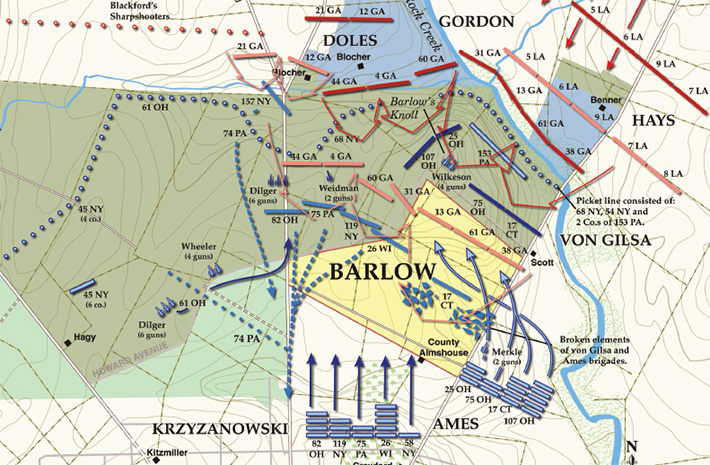Thanks to Charlene Henderson for the heads up on this from the Civil War Trust. I posted an excerpt here, but the full story can be found by clicking on the link below. While any chance to save battlefield land is important to seize upon, this is very relevant to the 17th CVI:
http://www.civilwar.org/battlefields/gettysburg/barlows-knoll-2016/message-from-jim-lighthizer.html
“Dear Fellow Battlefield Preservationist,
You have no idea how excited I am to tell you about this one.
I now have the honor and privilege to notify you that the Civil War Trust is undertaking one of its most important preservation efforts ever at the Gettysburg battlefield:
With your help, in the next 60 days, we will complete the preservation of Barlow’s Knoll at Gettysburg.
Today, with the chance to save the bloodiest unprotected 35 acres from the first day’s battle that can still be saved at Gettysburg, I don’t mind telling you that – in my humble opinion – this is without a doubt one of the most important historic preservation efforts at one of the most hallowed places in America.
If you have not already done so, please look now at the special map I have for you today, showing you exactly where this iconic site is.
Located just north of town and bordered by the historic Harrisburg and Carlisle Roads, this land saw intense combat on July 1, 1863, resulting in hundreds of casualties including Brigadier General Francis Channing Barlow.
The property we are working to save is literally only a few paces from the monument to General Barlow, whose actions during the battle forever affixed his name to what was previously known as Blocher’s Knoll. Incredibly, however, this 35-acre tract is not part of the Gettysburg National Military Park, and therefore is not permanently protected. Adams County, which has owned the property for decades, is giving the Trust the first time opportunity to acquire and preserve this landmark tract.
Residential and commercial development is already pressing heavily on the eastern and southern flanks of this crucial tract, making it urgent that the Civil War Trust purchase this land and save it immediately.
Fortunately for us (and for future generations), the county has agreed to sell the land for $400,000. Unfortunately, this is one of those rare instances – because of where the land is situated, inside the “authorized boundary” of the national military park – where we are unable to tap into any federal matching funds to help us make the purchase and save the land.
We are 100 percent on our own on this one, but there is good news: My staff and I have, for several weeks, been quietly approaching certain donors who have a special interest in Gettysburg.
The result of that outreach is that we have lined up gifts and commitments approaching $200,000, or about one-half of the total purchase price! So in effect, any gift you can give today will be matched dollar for dollar, not by government funds, but by the generosity of friends who have already stepped forward to save this hallowed ground.”
For those of you who are descendants of the 17th CVI, or maybe just students of the regiment, this parcel is one that is definitively linked to the 17th’s fight at Gettysburg on July 1, 1863. From Lt. Charles Doty:
“Passing through the city we were halted and passed into a grain field just beyond the poor house on the outskirts of the city. It was here that the Seventeenth was called upon to furnish a small detachment to guard a wooden bridge which the rebels were trying to destroy…The other seven companies under Colonel Fowler went with the brigade into a grain field at the left of the road, and were formed in double column, and halted just inside of the rail fence, a short distance from where their monument now stands. In the rear, the 107th Ohio were held in reserve, while the Seventy-fifth Ohio and the Fifty-fifth Ohio were advanced in line of battle to meet the enemy, who were now rushing into the fight very rapidly, and were pouring into us a terrible enfilading fire of musketry. About this time a battery upon the left of the brigade, having been ordered back upon Cemetery Hill, left an opening which General Ames was fearful the Johnnies might take advantage of to break through the line…This staff officer retiring to where the general stood was soon sent to Colonel Fowler, of the Seventeenth Connecticut, with instructions to move the regiment at once to the front to relieve the Seventy-fifth Ohio, and allow them to pass quickly through their ranks.
How well the writer remembers as he remained to see many of them for the last time.
Colonel Fowler at once rode to the front and gave the command to deploy column, and swinging his sword, said:
“Now, Seventeenth, do your duty! Forward, double quick! Charge bayonets!” and with a yell, which our boys knew how to give, they charged.
They fought and were mowed down in fearful numbers. Colonel Fowler soon fell, struck by a shell in the forehead, which scattered his brains all over the arm of Adjutant Chatfield, who was by his side. Captain Moore and many others were soon killed.”

